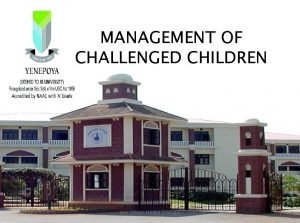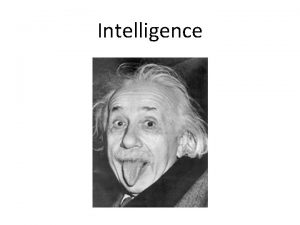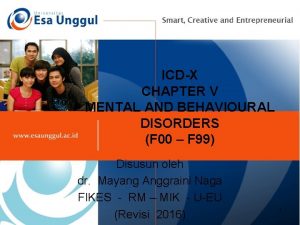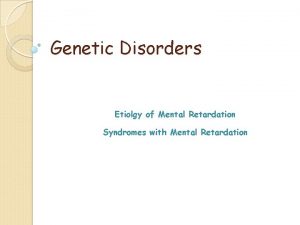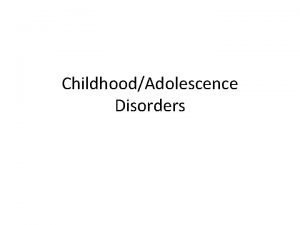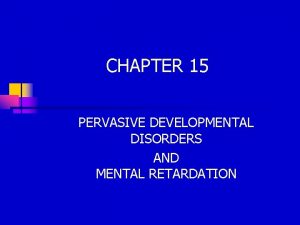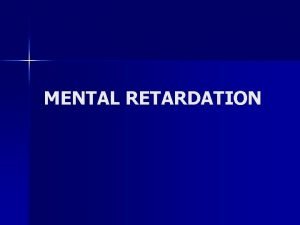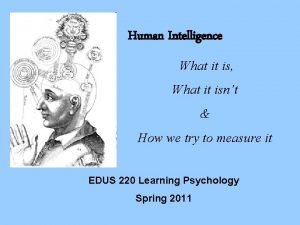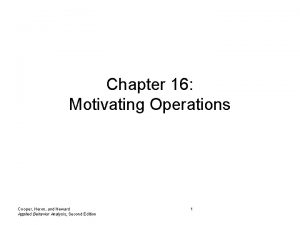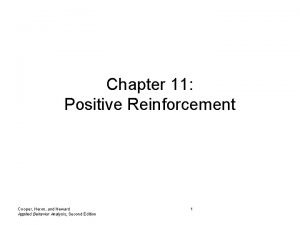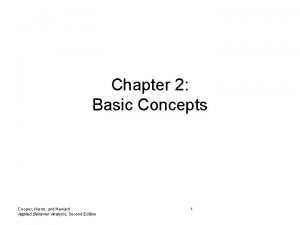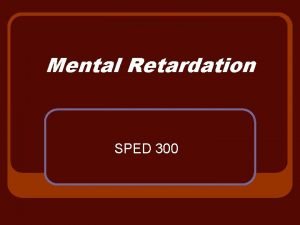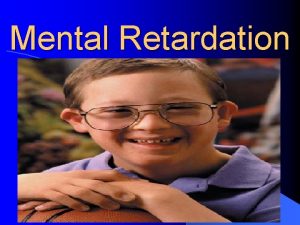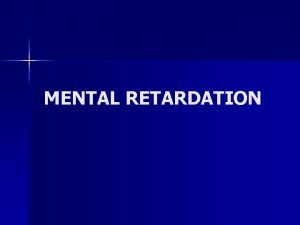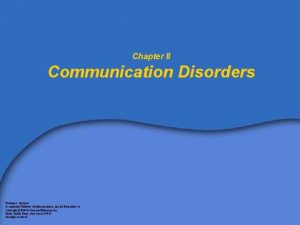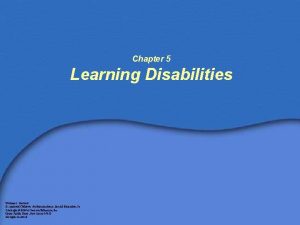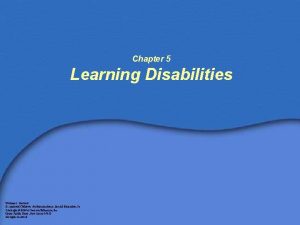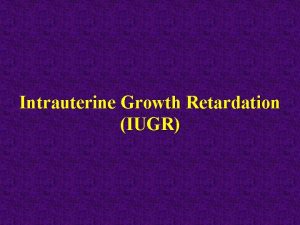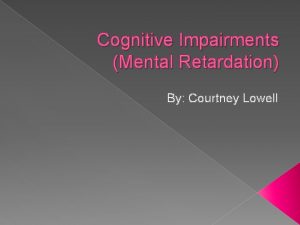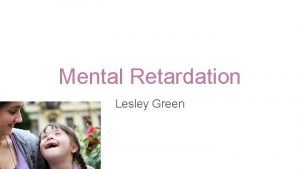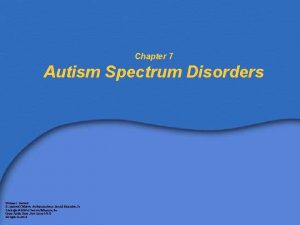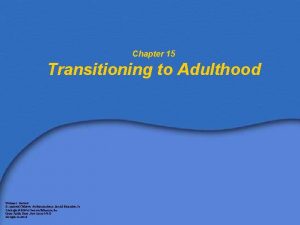Chapter 4 Mental Retardation William L Heward Exceptional














- Slides: 14

Chapter 4 Mental Retardation William L. Heward Exceptional Children: An Introduction to Special Education , 8 e Copyright © 2006 by Pearson Education, Inc. Upper Saddle River, New Jersey 07458 All rights reserved.

Definitions of Mental Retardation • AAMR’s 1983 definition in IDEA – Significantly subaverage intellectual functioning – Deficits in adaptive behavior – Manifested during the developmental period • AAMR’s new definition based on needed supports – Significant limitations in both intellectual functioning and conceptual, social, and practical adaptive skills; the disability originates before age 18 • Intensity of supports: – – Intermittent - As needed, short-term supports Limited - Consistent support for limited time Extensive - Consistent support in some settings Pervasive - Consistent, high intensity support in most settings William L. Heward Exceptional Children: An Introduction to Special Education , 8 e Copyright © 2006 by Pearson Education, Inc. Upper Saddle River, New Jersey 07458 All rights reserved.

Identification and Assessment Assessing Intellectual Functioning • Standardized tests are used to assess intelligence – A diagnosis of MR requires an IQ score at least 2 standard deviations below the mean (70 or less) • Important considerations of IQ tests: – – – IQ is a hypothetical construct IQ tests measure how a child performs at one point in time IQ tests can be culturally biased IQ scores can change significantly IQ testing is not an exact science Results are not useful for targeting educational objectives • Results should never be used as the sole basis for making decisions regarding special education services William L. Heward Exceptional Children: An Introduction to Special Education , 8 e Copyright © 2006 by Pearson Education, Inc. Upper Saddle River, New Jersey 07458 All rights reserved.

Normal Curve William L. Heward Exceptional Children: An Introduction to Special Education , 8 e Copyright © 2006 by Pearson Education, Inc. Upper Saddle River, New Jersey 07458 All rights reserved.

Assessing Adaptive Behavior • Adaptive behavior is the effectiveness or degree with which the individual meets the standards of personal independence and social responsibility expected of his age and social group – Measurement of adaptive behavior has proven difficult because of the relative nature of social adjustment and competence William L. Heward Exceptional Children: An Introduction to Special Education , 8 e Copyright © 2006 by Pearson Education, Inc. Upper Saddle River, New Jersey 07458 All rights reserved.

Prevalence and Causes Prevalence • During the 2000 -2001 school year, approximately 1% of the total school enrollment received special education services in the MR category • Mild MR cases make up about 85% of all persons with MR Causes • More than 750 causes of MR have been identified • For approximately 50% of mild MR cases and 30% of severe MR, the cause is unknown William L. Heward Exceptional Children: An Introduction to Special Education , 8 e Copyright © 2006 by Pearson Education, Inc. Upper Saddle River, New Jersey 07458 All rights reserved.

Biological Causes • Prenatal causes include: – – Chromosomal disorders Inborn errors of metabolism Developmental disorders Toxic exposure through maternal substance abuse • Perinatal causes include: – Intrauterine disorders – Neonatal disorders • Postnatal causes include: – – Head injuries Infections Degenerative disorders Malnutrition William L. Heward Exceptional Children: An Introduction to Special Education , 8 e Copyright © 2006 by Pearson Education, Inc. Upper Saddle River, New Jersey 07458 All rights reserved.

Environmental Causes William L. Heward Exceptional Children: An Introduction to Special Education , 8 e Copyright © 2006 by Pearson Education, Inc. Upper Saddle River, New Jersey 07458 All rights reserved.

Prevention • The biggest single preventive strike against MR was the development of the rubella vaccine in 1962 • Toxic exposure through maternal substance abuse and environmental pollutants are two major causes of preventable MR that can be combated with education and training • Advances in medical science have enabled doctors to identify certain genetic influences • Although early identification and intensive educational services to high-risk infants show promise, there is still no widely used technique to decrease the incidence of MR caused by psychosocial disadvantage William L. Heward Exceptional Children: An Introduction to Special Education , 8 e Copyright © 2006 by Pearson Education, Inc. Upper Saddle River, New Jersey 07458 All rights reserved.

Characteristics of Students with MR • Mild MR – Usually not identified until school age – Most students master many academic skills – Most able to learn job skills well enough to support themselves independently or semi-independently • Moderate MR – Most show significant delays in development during the preschool years – As they grow older the discrepancies in age related adaptive and intellectual skills widens • Severe MR – Usually identified at birth – Most have significant central nervous system damage – Likely to have health care problems that require intensive supports William L. Heward Exceptional Children: An Introduction to Special Education , 8 e Copyright © 2006 by Pearson Education, Inc. Upper Saddle River, New Jersey 07458 All rights reserved.

Educational Approaches Curriculum Goals • Functional curriculum – A functional curriculum will maximize a student’s independence, self-direction, and enjoyment in school, home, community, and work environments • Life skills – Skills that will help the student transition into adult life in the community • Self-determination – Self-determined learners set goals, plan and implement a course of action, evaluate their performance, and make adjustments in what they are doing to reach their goals William L. Heward Exceptional Children: An Introduction to Special Education , 8 e Copyright © 2006 by Pearson Education, Inc. Upper Saddle River, New Jersey 07458 All rights reserved.

Characteristics of Effective Instruction • Explicit and systematic instruction • Task analysis • Direct and frequent measurement of student performance • Active student response • Systematic feedback provided by the teacher • Transfer of stimulus control from prompts to task • Generalization and maintenance William L. Heward Exceptional Children: An Introduction to Special Education , 8 e Copyright © 2006 by Pearson Education, Inc. Upper Saddle River, New Jersey 07458 All rights reserved.

Educational Placement Alternatives • Some children with MR attend special schools • Most are educated in their neighborhood schools – Special classes – Regular class with support – Resource room • The extent to which a student with MR should be included in the regular classroom should be determined by the student’s individual needs William L. Heward Exceptional Children: An Introduction to Special Education , 8 e Copyright © 2006 by Pearson Education, Inc. Upper Saddle River, New Jersey 07458 All rights reserved.

Current Issues and Future Trends • Some concerns of the current definition of MR include: – IQ testing will remain the primary means of assessment – Adaptive skills cannot be reliably measured with current assessment methods – The levels of need supports are too subjective – Classification will remain essentially unchanged in practice • Acceptance and membership – An especially important and continuing challenge is moving beyond the physical integration of persons with MR in society to acceptance and membership that comes from holding valued roles William L. Heward Exceptional Children: An Introduction to Special Education , 8 e Copyright © 2006 by Pearson Education, Inc. Upper Saddle River, New Jersey 07458 All rights reserved.
 Conclusion for mental retardation
Conclusion for mental retardation Mental retardation classification
Mental retardation classification Mental retardation levels
Mental retardation levels Retardasi mental icd 10
Retardasi mental icd 10 Etiolgy
Etiolgy Mental retardation classification
Mental retardation classification Nursing diagnosis mental retardation
Nursing diagnosis mental retardation Mental retardation levels
Mental retardation levels Causes of mental retardation slideshare
Causes of mental retardation slideshare What are the classification of mental retardation
What are the classification of mental retardation Motivating operations examples
Motivating operations examples An example of shaping within a response topography is:
An example of shaping within a response topography is: Motivating operations examples
Motivating operations examples Heron
Heron Chapter 20 mental health and mental illness
Chapter 20 mental health and mental illness

